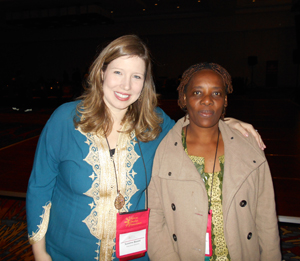
Dr Odero (on the right) pictured with Suzanne Baazet, ASA Executive Director at the Awards Ceremony. |
Dr Prisca Odero, a Centre for Africa Studies (CAS) fellow, received the African Studies Association (ASA) Presidential Fellow award in Indianapolis, USA, recently.
She was nominated for ASA by Dr Cyril Obi from the Social Science Research Council (New York), and was selected competitively, based on her PhD thesis and applied research work in rural development in Africa. Odero obtained her PhD in Africa Studies from the UFS at the July 2014 Graduation Ceremony.
On 22 November 2014, Dr Odero gave a public lecture at the Brooklyn College of the City University of New York. The event was hosted by the Political Science Department at the College.
Her paper, titled Sources and role of social capital in smallholder agricultural production: The value of membership of community groups to Zimbabwe rural livelihoods, sought to address the question of whether social capital contributed to the resilience of rural households in the face of economic difficulties and food security challenges. Dr Odero argued that the link between social capital and agricultural production is manifest in the ways in which farmers use social capital derived from membership of groups to alleviate agricultural production challenges.
Smallholder farmers in Zimbabwe, who face constraints in acquiring the necessary resources for production because of failing markets and reduced agri-industry productive capacity, employ a range of methods to deal with these challenges. She presented an analysis of data collected through focus group discussions with representative groups and through a household survey.
Dr Odero’s research forms part of a book project. While books on agricultural development knowledge do exist, more studies analysing issues and offering solutions from an African perspective would help to address the gap in African knowledge production.
For more information or enquiries contact news@ufs.ac.za